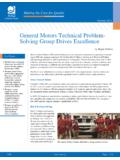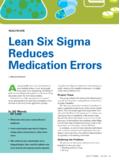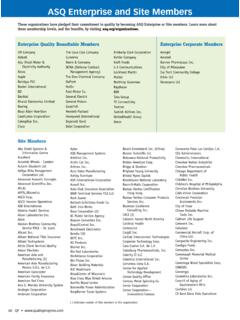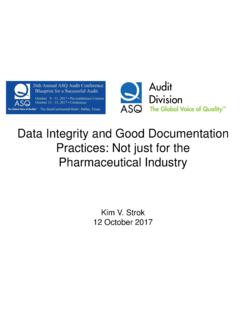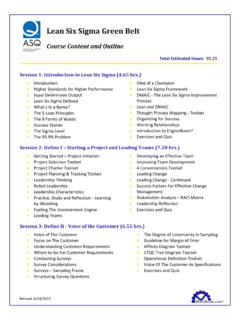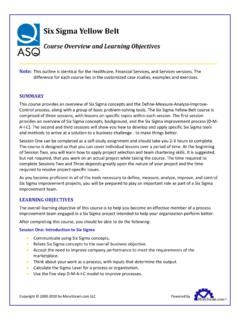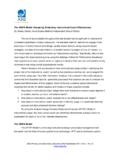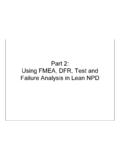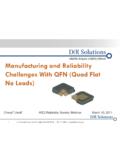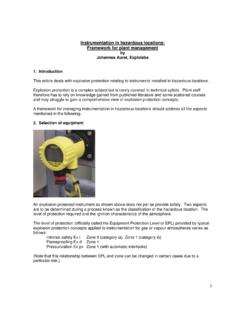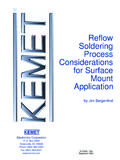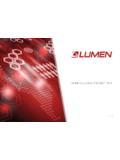Transcription of What we want What we ask for What we get
1 The Value of Workmanship Standards: what we want what we ask for what we get Jeannette Plante NASA Workmanship Standards Program Manager Code 300, Safety Mission Assurance Directorate, NASA GSFC. CQSDI Conference, March 2013. what do we want? what is the value of the Workmanship Standards? [Workmanship] Quality Assurance: Reduces occurrences Lunar Reconnaissance Orbiter (LRO). of defects Defects that prevent achieving: - intended design - durability goals (reliability). LRO Processor Board [Workmanship] Quality Assurance: Quality Baseline: Best we know how to build quality in at low level of assembly Screening for observable artifacts shown in the past to cause failure early in life (infant mortality) or when exposed to vibration, shock, and thermal cycling ( qualification ).
2 Guides (requires) manufacturers to processes known: to produce highly repeatable interconnects which haven't failed to reduce un-screenable defects (latent defects). Corrosion product on cables from flux residue Cracked solder joint following exposure to high numbers of thermal cycles [Workmanship] Quality Assurance: Ensures applied item is as good as qualified item Process repeatability provides traceability to qualification Thermal cycling of partially-filled solder joints Where do Workmanship defects come from? Unsuccessful design Low manufacturability Low-quality building blocks (parts and materials).
3 Under-developed or uncontrolled processes Untrained personnel Screening escapes Cracks ion surface of printed circuit board (PCB). How do we ask for absence of defects due to poor engineering design? From J-STD-001ES, The development [of acceptance criteria for nonstandard configurations] should include user involvement. The acceptance criteria shall have user agreement. Mounting and soldering requirements for specialized processes and/or technologies not specified herein shall be performed in accordance with documented procedures which are available for review. Excessive heat rise created in non-standard interconnect Printed Circuit Board coupon analysis + respinning non-compliant lots revealed this design to have very low manufacturability How do we ask for absence of defects due to poor engineering design?
4 From , para Precautions shall be taken to prevent the mismating of connectors, caused by interchanging or by reversing, through one of the following techniques: Use of constraints that locate similar connectors built into interconnecting cables and harnesses so they cannot be interchanged (Requirement). Selection of different sizes for connectors to be located adjacent to each other (Requirement). Polarization or dissimilar keying of adjacent, similar connectors (Requirement). How do we ask for absence of defects due to poor engineering design? From Mandatory Staking. All required staking shall be detailed on the engineering documentation (Requirement).
5 Jumper wires in excess of cm (1. inch) and axial leaded tantalum capacitors of all case sizes shall be staked. If parts are identified to be staked but staking location or staking dimensions are not specified on the engineering documentation, the following shall be used as default criteria . How do we ask for absence of defects due to low quality parts, materials and processes? From J-STD-001ES, Materials The materials and processes used to assemble/manufacture electronic assemblies shall be selected such that their use, in combination, produce products acceptable to this standard. Solder and flux defined, shelf life Prep required: cleaning, baking, tinning, gold removal Fixturing Tool calibration ESD Control Thermal shock protection Storage and handling How do we ask for absence of defects due to uncontrolled processes?
6 From J-STD-001ES, The Manufacturer shall develop and maintain operating procedures describing the reflow soldering process and the proper operation of the equipment. These procedures shall include, as a minimum, a reproducible time/temperature envelope including the flux and solder paste application procedures and coverage, drying/degassing operation (when required), preheating operation, controlled atmosphere (if used), solder reflow operation, and a cooling operation (see ). These steps may be part of an integral or in-line system or may be accomplished through a series of separate operations. When PCAs are required to be subjected to additional mass reflows in excess of the documented manufacturing process plan, the reason for the additional processing shall be documented, and notification shall be provided to the User within 24 hours.
7 From J-STD-001ES, When major elements of the proven processes are changed ( , flux, solder paste, cleaning media or system, solder alloy or soldering system), validation of the acceptability of the change(s) shall be performed and documented in accordance with approved tests agreed upon between the Manufacturer and User. The change shall be approved by the User prior to use. Major elements may also pertain to a change in bare boards (including supplier), solder resist, or metallization. How do we ask for absence of defects due to uncontrolled processes? From , para. The supplier shall assure that the design personnel are familiar with the requirements of this Standard, crimping, cabling, and harnessing techniques, and other pertinent requirements of the contract (Requirement).
8 The supplier shall implement and document a training program which provides the necessary training of fabrication and inspection personnel in crimping, cabling, and harnessing requirements and techniques (Requirement). Use of equipment and procedures pertinent to their responsibilities in performance of the contract requirements shall also be documented (Requirement). The supplier is responsible for certifying and maintaining the certification of each individual who fabricates, inspects, or instructs. Commitment to using known good designs, materials, parts, processes, and trained personnel also streamlines failure root cause analysis and continuous improvement.
9 How do we ask for defect screening? Inspection conditions defined Accept/reject criteria defined Operators and inspectors trained Most well known and understood parts of the Workmanship quality approach. Commercial-off-the-shelf (COTS). , para. , The workmanship requirements of [NASA's Workmanship Standards] do not apply to suppliers of commercial-off-the-shelf (COTS) items. Projects which use COTS. hardware for applications described in above are responsible for identifying and managing risk associated with hardware that was built without material controls, production methods, and/or quality inspections defined by the workmanship standards.
10 Source: Source: We know what we want. We have a way to ask for it. Do we always get it? No. Why don't we always get compliance to Workmanship requirements? Failure to flow down requirements. The requirements are there but they do not get applied or they are not flown down to subcontracts. WHY? Hardware is off-the-shelf . From heritage' NASA procurements which pre-date assurance requirements like Workmanship (includes subcontractors). Leveraging off of DoD, aeronautics, automobile, or commercial market where Workmanship requirements may not be uniformly applied. Supplier does not have the sophistication or volume to establish standard, qualified manufacturing processes University or other R&D interest Niche manufacturer; single source supplying item with unique performance Increasing absence of process engineering and packaging qualification testing.
